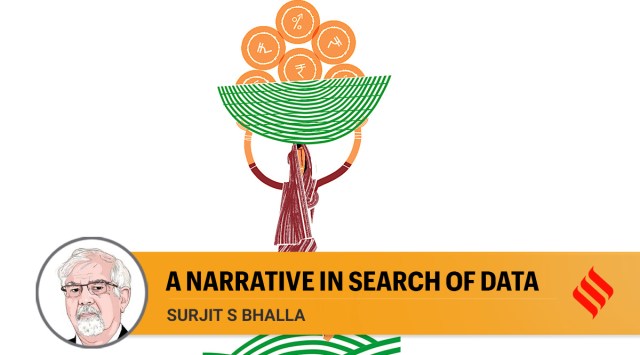
That India is one of the best-performing macro-economies in the world (the best by far in the G20 over the last two years) is now well established. However, the debate remains on whether this growth has translated into exceptional growth for the poor, especially in rural India. According to the most comprehensive wage data available in India (NSSO/PLFS), real casual worker wage growth between 2011 and 2021 is entirely consistent with macro GDP data.
These results are presented in the second half of this article. But first, a digression on the unfounded claims of Jean Dreze — former member of Sonia Gandhi’s Economic Advisory Council and Visiting Professor at Ranchi University — that my method of computation of real wage growth was flawed (‘Distress is there to see’, IE, May 24).
Even within the extreme limitations of the ILJ data, there are two approaches towards estimating the trend in real wages. One approach is to assume a common price level for all of rural India (Dreze, ‘Wages of distress’ IE, April 25 and ‘Distress is there to see’, IE May 24). An alternative is to use a state-specific consumer price index (Bhalla, ‘Wages are rising’, IE, April 25). It is well known that price levels and inflation vary enormously from state to state (for example, in rural Kerala, the price level is about 25 per cent higher than in rural Bihar; as is rural inflation. Between 2011-21, Kerala’s annual inflation rate was 6.2 per cent, vs 4.9 per cent in Bihar ). The second approach is to assume that the average all-India wage is just a simple average of all the ILJ state quotations (Dreze).
When workforce size varies across states, computing simple averages across states may misrepresent the true all-India wage level (and growth). Unfortunately, workforce information is not available in the ILJ data. Therefore, correct methods must incorporate state-region-specific inflation to arrive at the real wage, and weigh the wage information based on the number of workers in that occupation in each state. I use both state-specific inflation rates and the rural population in each state to obtain the average sex occupation wage across India.
In addition, the correct method for determining growth rate is to compute log growth rather than the incorrect arithmetic percentage growth as done by Dreze. Log growth ensures that base year values do not confound the computation of growth rates. To understand this, consider the following: Assume the wage is 80 in year one, 120 in year two, and 80 in year three. If growth is calculated on a simple arithmetic per cent change basis, then growth in year two is 50 per cent and in year three growth is minus 33.3 per cent. Average growth then (50-33.3)/2 is 8.5 per cent — this is incorrect given that real growth is zero. In log changes, however, the growth from 80 to 120 is 40.5 per cent; from 120 to 80, growth is equal and opposite at -40.5 per cent. Average growth: Zero per cent.
I use the log-growth method to compute growth changes (correct method). The unfortunate irony is that Dreze appears to be computing simple arithmetic percentage changes (the incorrect method), and accuses me of doing the same. Simply put, whatever the source of errors, Dreze’s growth estimates are flawed and inconsistent with other data and economic dynamics.
After these corrections (appropriate aggregations for states and correct growth dynamics), the results are radically different and convey very different information to policymakers and researchers; instead of Dreze’s 0.2 per cent average growth for rural male construction workers 2014-21, I obtain a growth average six times higher at 1.2 per cent. Same data, same variable, but look at the difference a correct specification makes. Arriving at correct estimates involves considerably more work than collecting eight all-India observations, as done by Dreze. My method involves using more than 2,000 units of data to estimate an all-India growth average.
I will now move to a considerably more important subject: What does the comprehensive NSS/PLFS data say about male rural wage changes 2011-2021? Four-digit industrial classification codes have been chosen to approximately capture rural India trends reported in ILJ data, and discussed above (see table). Data for four categories of rural work are reported: Agricultural workers in non-perennial crops like rice and wheat, perennial crops (like fruits and vegetables), construction and workers in elementary occupations.
In direct contrast to Dreze’s assertions and findings, poor rural workers appear to never have had it so good. Real wage growth (again CAGR and not simple percentage growth, the latter will always be higher as the reader can easily check) averaged 4.9 per cent per annum between 2011 and 2017, and a higher 5.3 per cent during 2017-2021. For construction workers, the average wage growth increases from 3 per cent (2011 to 2017) to 5 per cent per annum (2017-21). These PLFS male rural wage estimates are entirely consistent with national robust investment and growth, as observed in GDP data. In sharp contrast, ILJ construction worker wage growth for 2015-22 is reported by Dreze to be minus 0.02 per cent.
Unfortunately, these are fractured and polarised times, not just in India but in most parts of the democratic world. One can disagree with governments on their policies — for example, the need to dispense with the badly thought and designed, the policy of taxing individuals on their foreign spending on travel and software; the need for reform (read lowering) of income and GST tax rates. Or on the need to efficiently deliver social justice — for example, why has the conflict between wrestlers and their political boss, Brij Bhushan, been allowed to drag and drift for so long? If we are to function as a mature democracy, let us resolve to have an honest discussion, and implement policy.
The writer is former Executive Director, IMF and former member of PM Modi’s Economic Advisory Council